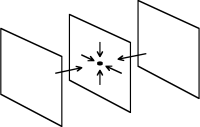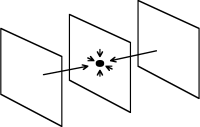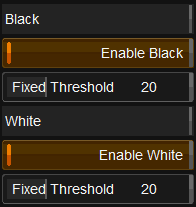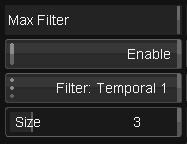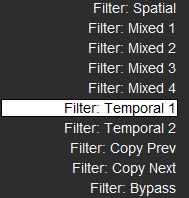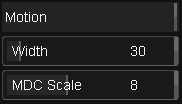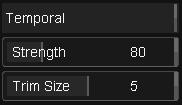UM:Dvo Effects Dvo Dropout
The filters used by the process are very important in determining the final processed quality. DVO Dropout includes a variety of filter algorithms that can effectively process a wide range of input footage.
This sets the size of the filter on the current field, so it is only required for spatial and temporal filters. Use the numeric slider to define the filter size.
The optimal size of dropout filter size is 3
| Range | 0 - 15 |
| Default | 3 |
The following generic filter groups are defined.
| Values | Spatial, Mixed 1, Mixed 2, Mixed 3, Mixed 4, Temporal 1, Temporal 2, Copy Prev, Copy Next, Bypass |
| Default | Mixed 3 |
Spatial
| All filters named Spatial are filters that work only within the current field i.e. it has taps only in the current field.
These filters are intended for very small spots. |
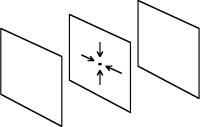
|
Mixed
Temporal
This toggles Adaptation on/off.
When off, DVO Dropout works in global mode and filters the whole image with the same fixed filter selected in the Filter menu.
| Range | 0 - 256 |
| Default | 30 |
This numeric slider configures the degree of motion sensitivity.
Initially you can set it to 0 (safest), for maximum motion sensitivity, and then increase it in steps if there is not enough filtering in moving parts of the picture. A value of 256 corresponds to no motion adaptation at all, which means that temporal filtering can be applied fully to moving parts of the image.
If there is motion on the pixel that you want to process, a value of 0 will disable processing and a value of 255 will allow it. The values between will allow less or more motion media to be processed.
| Default | OFF |
The MDC (Motion Detection Current) toggle button decides :
- Look at just the previous and next field or
- look at previous, next and current field
Having this option on ensures higher sensitivity and reduces artefacts to a minimum. For maximum filtering, the control is set to off.
If you start seeing visible artifacts from processing, enable MDC.
| Default | OFF |
This controls material edge protection.
Edge protection acts as a safety measure and reduces the possibility of false detection. Some material may require this protection e.g. houses at a distance, a forest or material with a slight weave.
By turning edge protection on, the built in edge detector will affect where DVO Dropout filters and it will reduce filtering where it finds edges.
| Default | OFF |
Toggle 'Temporal Adaptation on/off.
Temporal Adaptation acts to exclude falsely detected dropouts from being processed. It does this by comparing dropouts detected on the current field with dirt detected on the previous field (within a sizable window).
For static dropouts like head clogs, Temporal Adaptation needs to be in off mode.
| Default | ON |
There are two separate and independent parameter groups controlling the processing for Black (dark) and White (light) areas (or in chroma mode, high or low U or V levels).
White/black dropout removal can be enabled via the corresponding toggle button.
Note that if neither button is enabled then DVO Dropout will do no filtering at all.
| Range | 0 - 63 |
| Default | 20 |
You should lower the thresholds if you have very low contrast white dropouts on light background, or black dropout on dark background, and increase the thresholds if the luminance difference between the dropouts and the background is less.
 |
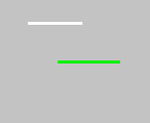
|
| Set the threshold lower. | Set the threshold higher. |
| Values | Y,U,V,R,G,B,Y+U+V |
| Default | Y |
This selects the signal (channel) within which dropout will be detected.
The detection works on one channel only, normally 'Y'. By setting the signal to 'U', for example, when only U dropouts are visible, the DVO Dropout will more precisely detect the chroma dropouts, minimizing the risk of affecting actual picture content.
| Values | Inside, Across, Bypass |
| Default | Inside |
This drop-down button gives options for how to process the frames surrounding an edit/cut point :
| Inside | Processes the field before a cut using only the current and previous field, and processes the field after a cut using only the current and next field. Stays inside the shot. |
| Across | Ignores cuts, use the previous, current, and next frame. Goes across shots. |
| Bypass | Does not process the frames before or after a cut. |
| Default | OFF |
Turning on the View toggle button will provide an overlay/preview showing detection. The type of overlay can be selected via the View Mode drop-down list (below).
| Values | Dirt On Luma, Dirt On Red Input, Dirt On Red Output, Difference |
| Default | Dirt on Luma |
Choose the mode we use to view the dropouts :
| Dirt On Luma | The detected dropout are high-lighted on a monochrome input picture with lowered luminance. |
| Dirt On Red Input | The detected dropout are shown with red on the unprocessed input signal. |
| Dirt On Red Output | The detected dropouts are shown with red on the processed output signal. |
| Difference | The difference between the unprocessed input and the processed output is displayed. |
| Range | 0 - 15 frames |
| Default | 5 |
DVO Dropout works recursively. This means the result on any one frame depends on previous frames.
For best results a certain amount of frame history needs to be built up. This numeric slider is used to specify how many frames of history to use.
| Default | ON |
Use Handles controls whether the history includes available handles of a scene/shot.
Normally, the history frames accumulated will terminate on a shot edit/event (start/end edit). There may be extra frames available (handles) before or after the start and end edit points of a shot however and these will be included as history if Use Handles is enabled.
If handles exist, full and precise processing will be available from the first frame of a clip.
| Default | OFF |
Enable Max Filter to add a second filter (in addition to that in the Processing tab).
| Values | Spatial, Mixed 1, Mixed 2, Mixed 3, Mixed 4, Temporal 1, Temporal 2, Copy Prev, Copy Next, Bypass |
| Default | Temporal 1 |
Use this drop-down button to select the maximum filter with which to process large dropouts.
When the Max Filter is enabled, the normal filter used for the adaptive filter sizing will take care of the small dirt. When the upper size limit is reached it will automatically switch over to the filter selected here.
The filter used here would typically be a larger temporal filter.
| Range | 0 - 15 |
| Default | 3 |
This specifies the size of the spatial part of the filter (for spatial and mixed filter types).
| Range | 0 - 255 |
| Default | 30 |
Motion Width is used in combination with the Motion control in the Processing section and defines the motion adaptation behaviour.
- Zero - When Motion Width is set to 0, the motion setting will be used as a threshold discriminating between moving and non-moving parts.
- Non-Zero - When Motion Width is set to a non-zero value, the classification will change gradually from “no motion” to “full motion”. Motion width then specifies the size of the transition region.
| Range | 0 - 15 |
| Default | 8 |
The MDC (Motion Detection Current) toggle button in the Processing section determines whether to look at just the previous and next field/frame, or to look at all of the previous, current, and next field/frame.
The higher the MDC Scale setting, the more filtering (less impact of the MDC algorithm).
Only used if MDC (Motion Detection Current) control enabled in the Processing section.
The purpose of temporal adaptation is to exclude false detection from processing by comparing it with the detection on the previous frame within a sizable window.
| Range | 0 - 255 |
| Default | 80 |
The Strength level determines the amount of influence that the detected dropouts on the previous frame will have on exclusion of dropout detection in the current frame.
A higher value will result in more dropouts being excluded and less processing carried out.
| Range | 0 - 7 |
| Default | 5 |
The Trim Size corresponds to a "window" in the previous frame which is searched for dropouts to compare against the current frame. The smaller the window (trim size) the more filtering that will be achieved.
The Hit Growth control is useful when the dirt in the image does not have well-defined edges.
By increasing the hit growth the processor is told that the dropout is bigger than it actually appears. The result is that the soft edges also are processed.
| Range | 0 - 15 |
| Default | 3 |
In relative mode large dropout cause a larger growth.
The Relative slider controls the amount of hit mask growth. The higher the value, the larger the area around the dropout will be processed.


